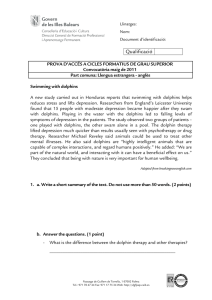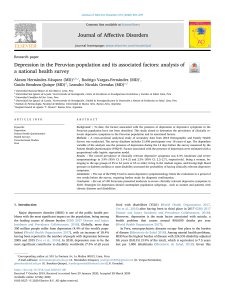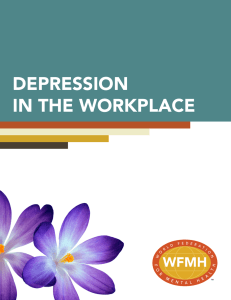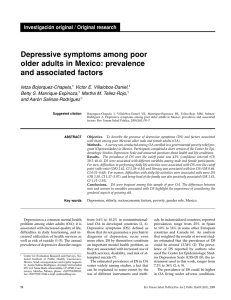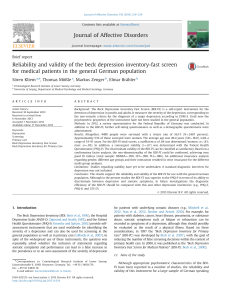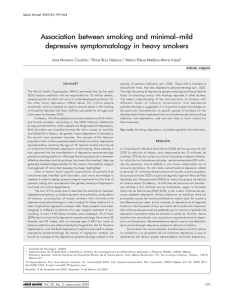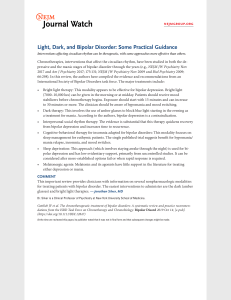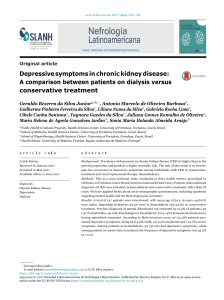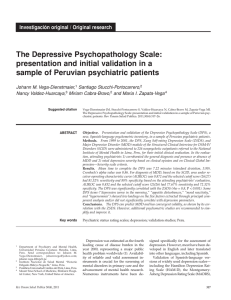Clinical utility of cognitive-behavioral techniques as a treatment for
Anuncio
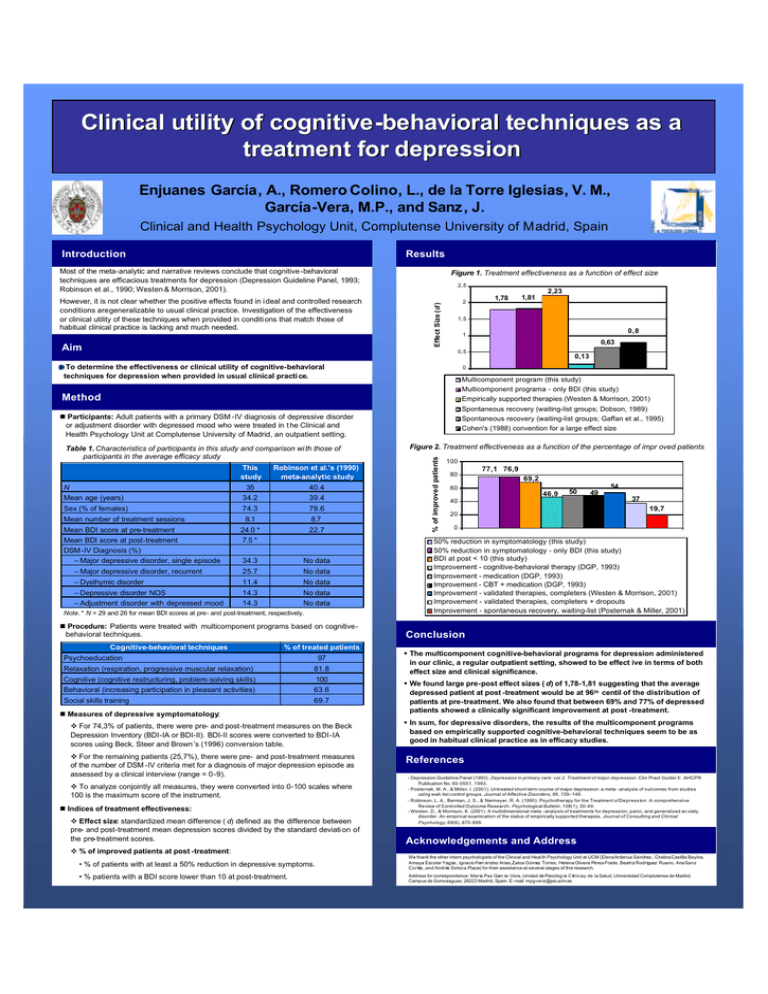
Clinical utility of cognitive -behavioral techniques as a treatment for depression Enjuanes García, A., Romero Colino, L., de la Torre Iglesias, V. M., García-Vera, M.P., and Sanz , J. Clinical and Health Psychology Unit, Complutense University of Madrid, Spain Introduction Results Most of the meta-analytic and narrative reviews conclude that cognitive -behavioral techniques are efficacious treatments for depression (Depression Guideline Panel, 1993; Robinson et al., 1990; Westen & Morrison, 2001). Aim 2,5 2,23 2 Effect Size (d ) However, it is not clear whether the positive effects found in i deal and controlled research conditions aregeneralizable to usual clinical practice. Investigation of the effectiveness or clinical utility of these techniques when provided in conditi ons that match those of habitual clinical practice is lacking and much needed. Figure 1. Treatment effectiveness as a function of effect size 1,78 1,81 1,5 0,8 1 0,63 0,5 To determine the effectiveness or clinical utility of cognitive-behavioral techniques for depression when provided in usual clinical practi ce. Multicomponent program (this study) Multicomponent programa - only BDI (this study) Empirically supported therapies (Westen & Morrison, 2001) Spontaneous recovery (waiting-list groups; Dobson, 1989) Spontaneous recovery (waiting-list groups; Gaffan et al., 1995) Cohen's (1988) convention for a large effect size Method n Participants: Adult patients with a primary DSM -IV diagnosis of depressive disorder or adjustment disorder with depressed mood who were treated in t he Clinical and Health Psychology Unit at Complutense University of Madrid, an outpatient setting. This study Robinson et al.’s (1990) meta-analytic study 35 40.4 Mean age (years) 34.2 39.4 Sex (% of females) 74.3 79.6 8.1 8.7 Mean BDI score at pre-treatment 24.0 * 22.7 Mean BDI score at post-treatment DSM -IV Diagnosis (%) 7.5 * N Mean number of treatment sessions – Major depressive disorder, single episode 34.3 No data – Major depressive disorder, recurrent 25.7 No data – Dysthymic disorder 11.4 No data – Depressive disorder NOS 14.3 No data – Adjustment disorder with depressed mood 14.3 No data v Note. * N = 29 and 26 for mean BDI scores at pre- and post-treatment, respectively. n Procedure: Patients were treated with multicomponent programs based on cognitivebehavioral techniques. Cognitive-behavioral techniques % of treated patients Psychoeducation Relaxation (respiration, progressive muscular relaxation) 97 81.8 Cognitive (cognitive restructuring, problem-solving skills) 100 Behavioral (increasing participation in pleasant activities) 63.6 Social skills training 69.7 n Measures of depressive symptomatology: v For 74,3% of patients, there were pre- and post-treatment measures on the Beck Depression Inventory (BDI-IA or BDI-II). BDI-II scores were converted to BDI-IA scores using Beck, Steer and Brown’s (1996) conversion table. v For the remaining patients (25,7%), there were pre- and post-treatment measures of the number of DSM -IV criteria met for a diagnosis of major depression episode as assessed by a clinical interview (range = 0-9). v To analyze conjointly all measures, they were converted into 0-100 scales where 100 is the maximum score of the instrument. n Indices of treatment effectiveness: v Effect size: standardized mean difference ( d) defined as the difference between pre- and post-treatment mean depression scores divided by the standard deviati on of the pre-treatment scores. Figure 2. Treatment effectiveness as a function of the percentage of impr oved patients % of improved patients Table 1. Characteristics of participants in this study and comparison wi th those of participants in the average efficacy study 0,13 0 100 80 77,1 76,9 69,2 60 46,9 50 40 20 49 54 37 19,7 0 50% reduction in symptomatology (this study) 50% reduction in symptomatology - only BDI (this study) BDI at post < 10 (this study) Improvement - cognitive-behavioral therapy (DGP, 1993) Improvement - medication (DGP, 1993) Improvement - CBT + medication (DGP, 1993) Improvement - validated therapies, completers (Westen & Morrison, 2001) Improvement - validated therapies, completers + dropouts Improvement - spontaneous recovery, waiting-list (Posternak & Miller, 2001) Conclusion § The multicomponent cognitive-behavioral programs for depression administered in our clinic, a regular outpatient setting, showed to be effect ive in terms of both effect size and clinical significance. § We found large pre-post effect sizes ( d) of 1,78-1,81 suggesting that the average depressed patient at post -treatment would be at 96 th centil of the distribution of patients at pre-treatment. We also found that between 69% and 77% of depressed patients showed a clinically significant improvement at post -treatment. § In sum, for depressive disorders, the results of the multicomponent programs based on empirically supported cognitive-behavioral techniques seem to be as good in habitual clinical practice as in efficacy studies. References - Depression Guideline Panel (1993). Depression in primary care: vol.2. Treatment of major depression . Clin Pract Guidel 5: AHCPR Publication No. 93-0551, 1993. - Posternak, M. A., & Miller, I. (2001). Untreated short-term course of major depression: a meta -analysis of outcomes from studies using wait-list control groups. Journal of Affective Disorders, 66 , 139–146. - Robinson, L. A., Berman, J. S., & Neimeyer, R. A. (1990). Psychotherapy for the Treatment of Depressíon: A comprehensive Review of Controlled Outcome Research. Psychological Bulletin, 108(1), 30-49. - Westen, D., & Morrison, K. (2001). A multidimensional meta -analysis of treatments for depression, panic, and generalized an xiety disorder. An empirical examination of the status of empirically supported therapies. Journal of Consulting and Clinical Psychology, 69(6), 875-899. Acknowledgements and Address v % of improved patients at post -treatment: • % of patients with at least a 50% reduction in depressive symptoms. We thank the other intern psychologists of the Clinical and Heal th Psychology Unit at UCM (Elena Arderius Sánchez , Cristina Castilla Baylos, Amaya Escolar Yagüe, Ignacio Fern ández Arias,Zaloa Gómez Torres, Helena Olivera Pérez-Frade, Beatriz Rodríguez Ruano, Ana Sanz Cortés , and Andrés Sotoca Plaza) for their assistance at several stages of this research. • % patients with a BDI score lower than 10 at post-treatment. Address for correspondence: María Paz Garc ía-Vera, Unidad de Psicolog ía C línica y de la Salud, Universidad Complutense de Madrid, Campus de Somosaguas, 28223 Madrid, Spain. E -mail: mpgvera@psi.ucm.es

